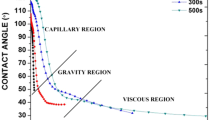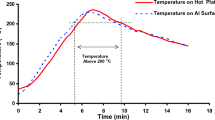Abstract
Several candidate alloys have been suggested as high-temperature lead-free solder for Si die attachment by different researchers. Among them, Zn–Al based alloys have proper melting range and excellent thermal/electrical properties. In this study, Zn–Al–Mg–Ga solder wire was used to attach Ti/Ni/Ag metallized Si die on Cu lead-frame in an automatic die attach machine. Die attachment was performed in a forming gas environment at temperature ranging from 370 to 400 °C. At the interface with Cu lead-frame, CuZn4, Cu5Zn8 and CuZn intermetallic compound (IMC) layers were formed. At the interface with Si, Al3Ni2 IMC formed when 200 nm Ag layer was used at the die back and AgZn and AgZn3 IMC layers when the Ag layer was 2,000 nm thick. Microstructure of the bulk solder consists of mainly two phases: one with a brighter contrast (about 80.9 wt% Zn) and the other one is a mixture of light (about 73.7 wt% Zn) and dark phases (about 45 wt% Al). Zn–Al–Mg–Ga solder wetted well on Cu lead-frame, covered entire die area and flowed in all directions under the Si die. Less than 10% voids were found in the die attach samples at die attach temperatures of 380 and 390 °C. Die shear strength was found within the acceptable limit (21.8–29.4 MPa) for all the die attach temperatures. Die shear strength of standard Pb–Sn solder was also measured for comparison and was found to be 29.3 MPa. In electrical test, maximum deviation of output voltage after 1,000 thermal cycles was found 12.1%.












Similar content being viewed by others
References
T. Soga, T. Ishida, K. Miura, H. Hata, M. Okamoto, T. Nakatsuka, Hitachi Ltd., (Tokyo, JP), United States Patent US 6563225 (2003)
E. Union (ed.), Eur-Lex, Official J. Eur. Union online. 46(L37), 19–23 (2003)
K. Suganuma, Curr. Opin. Solid State Mater. 5, 55–64 (2001)
K.S. Kim, S.H. Huh, K. Suganuma, Microelectron. Reliab. 43, 259–267 (2003)
I.E. Anderson, J. Mater. Sci. Mater. El. 18, 55–76 (2007)
K.N. Tu, A.M. Gusak, M. Li, J. Appl. Phys. 93, 1335–1853 (2003)
J.W. Jang, L.N. Ramanathan, J.K. Lin, D.R. Frear, J. Appl. Phys. 95, 8286–8289 (2004)
RoHS Regulations (UK) Government Guidance Notes. (2010). URN 10/590
S. Kim, K.S. Kim, S.S. Kim, K. Suganuma, I. Goro, J. Electron. Mater. 38, 2668–2675 (2009)
K. Suganuma, S.J. Kim, K.S. Kim, JOM 61, 64–71 (2009)
C. Tschudin, O. Hutin, S. Arsalane, F. Bartels, P. Lambracht, M. Rettenmayr, in SEMICON China (2002), March 26–27, on Semiconductor Equipment and Materials International (SEMI): Shanghai
C.Y. Liu, K.N. Tu, J. Mater. Res. 13, 37–44 (1998)
J. Kim, S. Jeong, H. Lee, J. Electron. Mater. 31, 557–563 (2002)
J.Y. Tsai, C.W. Chang, Y.C. Shieh, Y.C. Hu, C.R. Kao, J. Electron. Mater. 34, 182–187 (2005)
H. Song, J. Ahn, J. Morris, J. Electron. Mater. 30, 1083–1087 (2001)
J. Lalena, N. Dean, M. Weiser, J. Electron. Mater. 31, 1244–1249 (2002)
S.J. Kim, K.S. Kim, S.S. Kim, C.Y. Kang, K. Suganuma, Mater. Trans. 49, 1531–1536 (2008)
T. Shimizu, H. Ishikawa, I. Ohnuma, K. Ishida, J. Electron. Mater. 28, 1172–1175 (1999)
K. Suganuma, Japan Patent 2004-237375 (2004)
S. Kim, K.S. Kim, S.S. Kim, K. Suganuma, J. Electron. Mater. 38, 266–272 (2009)
J.M. Song, H.Y. Chuang, Z.M. Wu, J. Electron. Mater. 35, 1041–1049 (2006)
M. Rettenmayr, P. Lambracht, B. Kempf, C. Tschudin, J. Electron. Mater. 31, 278–285 (2002)
M. Nobumasa, N. Shuichi, Japan Patent 2006-320913 (2006)
Y. Takaku, L. Felicia, I. Ohnuma, R. Kainuma, K. Ishida, J. Electron. Mater. 37, 314–323 (2008)
N. Kang, H.S. Na, S.J. Kim, C.Y. Kang, J. Alloys Compd. 467, 246–250 (2009)
SGTE Alloy Phase Diagrams (2004), http://www.crct.polymtl.ca/fact/documentation/SGTE/SGTE_Figs.htm. Accessed 20 Oct 2010
Y. Takaku, K. Makino, K. Watanabe, I. Ohnuma, R. Kainuma, Y. Yamada, Y. Yagi, I. Nakagawa, T. Atsumi, K. Ishida, J. Electron. Mater. 38, 54–60 (2009)
Acknowledgments
The authors would like to thank ON Semiconductor, Package Innovation & Development Center (PIDC), 70450 Seremban, Negeri Sembilan, Malaysia for providing material, using production machineries and lab support. This work was supported by University of Malaya, 50603 Kuala Lumpur, Malaysia, under research grants of IPPP (PS073/2009B), Science fund (13-02-03-3072), FRGS fund (FP013/2010B) and UMRG fund (RG068/09AET).
Author information
Authors and Affiliations
Corresponding author
Rights and permissions
About this article
Cite this article
Haque, A., Lim, B.H., Haseeb, A.S.M.A. et al. Die attach properties of Zn–Al–Mg–Ga based high-temperature lead-free solder on Cu lead-frame. J Mater Sci: Mater Electron 23, 115–123 (2012). https://doi.org/10.1007/s10854-011-0511-x
Received:
Accepted:
Published:
Issue Date:
DOI: https://doi.org/10.1007/s10854-011-0511-x




